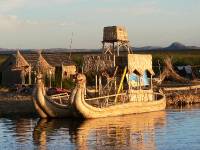Profile
Blog
Photos
Videos
It took my legs about 2 days to recover from the Inca Trail so after that I caught a bus to Puno, on the banks of the Peruvian side of Lake Titicaca. It straddles the border of Peru and Bolivia. The Peruvians say they own 60% of the lake and the Bolivians 40% and the Bolivians say the exact opposite although this doesn't seem to cause too much squabbling. It's an enormous lake and the world's largest high altitude body of water at 3870 metres above sea level.
I visited the floating Uros Islands which are man made by lashing together clumps of totora reeds and their roots which float like corks. The Aymara people fled to the lake from the Incas and originally lived in boats where they then decided that building themselves islands would be an improvement on living in boats.
There are 42 floating islands all side by side with huts and boats all made of the reeds. Each island can support from 2 to 10 families. They have been given solar panels by the government for electricity as they had a nasty habit of accidentally burning their huts down using candles previously.
I then went on to the (natural) island of Taquile which is recognised by UNESCO (just about everywhere in South America seems to be UNESCO recognised) for the quality of it's weaving. I managed to resist buying anything (it's getting very difficult to fit everything in my rucksack these days) and had a wander round the island which was beautiful. Life there obviously hasn't changed much in the last few hundred years, ox are still used to till the soil and it has a very sleepy feel about it. We ate fresh trout from the lake on a hillside in the sunshine overlooking the blue skies and waters.
On Wednesday I decided to make the most of the time I have travelling and caught a bus accross the border to La Paz in Bolivia.
- comments




